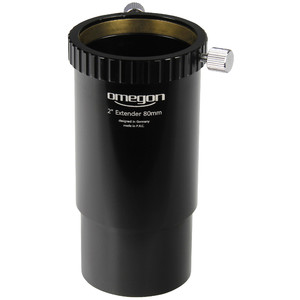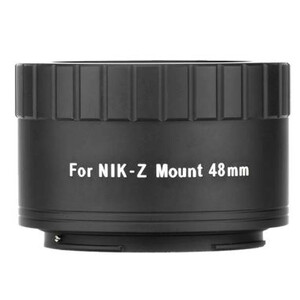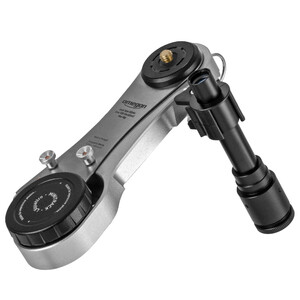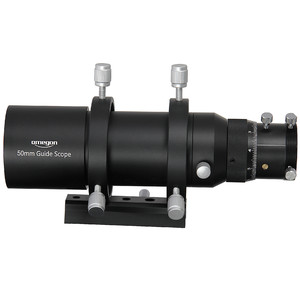Clipfilter för spegellösa Nikon Z fullformatskameror: Z5, Z6 och Z7
Filtren sitter säkert och spänningsfritt i kameran. Montering och demontering går snabbt och enkelt! Inga ändringar av kameran krävs för att använda filtren.
Clip-filtren är optimerade för användning med både vanliga kameraobjektiv och teleskop.
På grund av det trånga utrymmet i kamerorna kan clip-filtren med vissa optiker orsaka en oundviklig, minimal extra skuggning som kan korrigeras med Flatfield. Inte kompatibel med den ursprungliga Nikon Z 2.0x telekonverter.
Detta filter är lämpligt för fotografering och observation från områden med konstgjort ljus. Kontrasten för alla Deep Sky-objekt förstärks.
CLS-filtret ökar kontrasten mellan astronomiska objekt och himmelbakgrunden. Tack vare den stora halvvärdesbredden släpps en motsvarande stor mängd ljus igenom, vilket innebär att stjärnorna endast dämpas något. CLS-filtret är utformat för att blockera så mycket störande ljus som möjligt och samtidigt släppa igenom så mycket ljus som möjligt från objekten. Det meningsfulla användningsområdet sträcker sig för visuell observation över ett bländarförhållande på 1:2 till 1:15 för teleskop från 2" (50 mm) öppning och för CCD-, DSLR- och kemisk svartvit fotografering via objektiv och teleskop av alla diametrar.
Verkningssätt
Filtret blockerar emissionslinjerna från låg- och högtryckslampor (kvicksilver (Hg) och natrium (Na)) och linjerna från airglow helt. Alla viktiga emissionslinjer från astronomiska objekt samt det spektralområde där ögat har maximal känslighet på natten släpps igenom.
Tips och ytterligare användningsanvisningar
I varianten som EOS Clip Filter möjliggör filtret fotografering med DSLR-kameror även vid extrem ljusförorening utan att färgbalansen påverkas.
Alternativ
Om det inte finns något inbyggt IR-blockeringsfilter för elektronisk fotografering krävs ett CLS CCD-filter.
Filterets lämplighet
- Visuell observation (land): Bra, vid ljusföroreningar från kvicksilverlampor
- Visuell observation (stad): Bra, ett UHC-E- eller UHC-filter är lämpligare
- Konventionell film: Mycket bra, vitbalansen är mycket bra
- CCD-astrofotografering: Bra, extra IR-blockerare krävs
- DSLR-astrofotografering (omodifierad): Bra, viss färgförskjutning, men förbättrad kontrast
- DSLR-astrofotografering (astromodifierad): Mycket bra, vitbalansen är mycket bra
- DSLR-astrofotografering (ombyggd med MC-klarglas): Bra, extra IR-blockerare krävs
- Webbkamera/video (Planet): Olämpligt
- Webbkamera/video (Deep Sky): Mycket bra om ljusföroreningar är ett stort problem
Tekniska data för filtret
- 92 % transmission vid 486 nm (H-beta)
- 92 % transmission vid 496 nm (OIII)
- 92 % transmission vid 501 nm (OIII)
- 97 % transmission vid 656 nm (H alfa)
- Genomsläppningsområde 450 nm till 540 nm och större än 650 nm
- Homofokal med alla andra Astronomik-filter
- Filtertjocklek: 1 mm
- Fuktbeständig, åldras inte, reptålig
- Finoptiskt polerat bärarmaterial
- Filtret levereras i en hållbar förpackning
Ett litet urval:
- Som första filter rekommenderar vi Astronomik CLS-filter. Detta filter dämpar i hög grad artificiell ljusförorening och naturligt luftglöd. När du använder detta filter får du en mörk himmelbakgrund och kan därför exponera mycket längre och därmed göra svagare objekt synliga. Filtret är optimerat så att objekten återges i naturliga färger. Viktigt: Det enkla CLS-filtret har ingen inbyggd IR-blockering. Därför behöver du CLS-CCD-filtret för en ombyggd kamera ("astromodifierad")!
- Ett bra val för arbete på platser med riktigt stark ljusförorening är Astronomik UHC-filter. Transmissionskurvan för detta filter släpper endast igenom ljus från linjerna H-beta, OIII, H-alfa och SII. Undertryckningen av himmelbakgrunden är betydligt starkare än med CLS, men detta filter fungerar endast på gasnebulosor! Stjärnhopar och galaxer filtreras bort i stor utsträckning.
- För en djupare introduktion till astrofotografering rekommenderar vi emissionslinjefiltren OIII, H-alpha och SII, tillgängliga med halvvärdesbredder på 6nm eller 12nm. Med dessa filter kan du även från platser med extrem ljusförorening och fullmåne högt på himlen ta riktigt djupa bilder av svaga objekt. Bilder i dessa smala linjer är naturligtvis inte färgade.
- För ägare av ombyggda ("astromodifierade") kameror rekommenderar vi Astronomik OWB-filter: OWB står för "Original White Balance". Filtret korrigerar den förskjutna färgåtergivningen hos en ombyggd kamera, så att du återigen kan använda din kamera för normal vardagsfotografering utan att behöva bearbeta varje bild på datorn.






